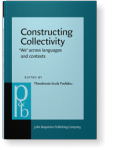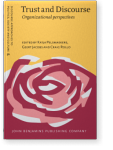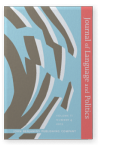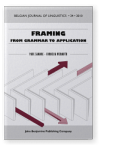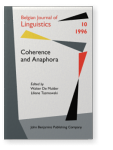Martina Temmerman
List of John Benjamins publications for which Martina Temmerman plays a role.
2014 “Nail polish – We’ve chosen the nicest shades for you!”: Editorial voice and ‘we’ in a Flemish women’s magazine Constructing Collectivity: 'We' across languages and contexts, Pavlidou, Theodossia-Soula (ed.), pp. 247–264 | Article
This chapter analyses the discursive strategies text producers of a Flemish women’s magazine adopt by using the first person plural pronoun. The analysis shows that in some instances, exclusive ‘we’ is used to create a distance between the editorial voice and the readers. The editorial voice gets… read more
2014 Chapter 8. “Trust us: Bootcamp Pilates does not sound half as hard as it is, but it works”: The credibility of women’s magazines Trust and Discourse: Organizational perspectives, Pelsmaekers, Katja, Geert Jacobs and Craig Rollo (eds.), pp. 161–180 | Article
2012 Elite behaviour and elite communication in a divided society: The Belgian federal coalition formation of 2007 Journal of Language and Politics 11:4, pp. 500–520 | Article
Consociational democracy theory attributes an important role to the subgroup elites. They have to build the bridges between the subgroups and govern together in a divided and segmented society. This need for an accommodating elite has been criticized — among others — for its unrealistic… read more
2010 Naming and framing in Belgian politics: An analysis of the representation of politicians and the political state of affairs during the 2007 government formation period in the Belgian press Framing: From grammar to application, Sambre, Paul and Maria-Cornelia Wermuth (eds.), pp. 120–138 | Article
This paper describes the way Belgian politicians represented themselves, their parties and the political situation in newspaper interviews in the government formation period of 2007. Interviews with four politicians, both in Dutch and in French, have been analyzed in order to reconstruct the image… read more
1996 Dutch Anaphoric Dat in Definitions Coherence and Anaphora, De Mulder, Walter and Liliane Tasmowski (eds.), pp. 207–220 | Article
Abstract. Dutch anaphoric dat has an important function in definitory exchanges. If dat is used in the recapitulation of a non-nominal definition, it increases the coherence of the defining utterance, by tying the recapitulation to the previous utterances and by permitting the switch of the focus… read more
